Pengembangan Biosensor Berbasis Kertas untuk Penentuan Aktivitas Antihiperlipidemia Pada Sampel Ekstrak Tanaman
DOI:
https://doi.org/10.19184/pk.v9i2.19051Keywords:
Antihyperlipidemia, Biosensor, Plant Extracts, LipaseAbstract
A biosensor is an alternative method to determine the antihyperlipidemic activity to be more simple, effective, and efficient in various herbal extracts. This study aimed to develop a biosensor with the principle of pancreatic lipase enzyme inhibition in paper microzone plates using Whatman filter paper for the matrix, 200 unit/mL of lipase enzyme solution, 1% extract, and 80 mM p-NPB substrate. This paper-based biosensor method shows results that fulfilled the several characterizations, that are the 30 min of the incubation time; linearity using 7 standards orlistat concentrations of 5-35 mg/mL with the regression equation of Y= 22.09585 + 2.170514X, correlation coefficient value (r)= 0.9996745, Vx0= 1.509906%, Xp= 1.572533 mg/mL; LOD and LOQ are 1,573 mg/mL and 4,718 mg/mL; precision with RSD value of 2.545%; accuracy with % recovery value of 99.222%; biosensor usage time after storage remained stable for 3 days at chiller temperatures and for 45 minutes at room temperature. The paper-based biosensor can be an alternative method for detecting antihyperlipidemic activity in plant extracts as same as UV-Vis spectrophotometry method.
Downloads
References
2. Mardiana L. Daun Ajaib Tumpas Penyakit. Jakarta: Penebar Swadaya; 2012.
3. Swierczewska A, Buchholz T, Melzig MF, Czerwi ME. In vitro a-amylase and pancreatic lipase inhibitory activity of Cornus mas L . and Cornus alba L . fruit extracts a. 2018;7:1–10.
4. Moniem A, Hassan S. TLC Bioautographic Method for Detecting Lipase Inhibitors. 2011;(October):3–5.
5. Dechakhamphu A, Wongchum N. Screening for anti-pancreatic lipase properties of 28 traditional Thai medicinal herbs. Asian Pac J Trop Biomed [Internet]. Elsevier (Singapore) Pte Ltd; 2015;1–4.
Available from: http://dx.doi.org/10.1016/j.apjtb.2015.09.012
6. Novianto F. Jamu Saintifik Suatu Lompatan Ilmiah Pengembangan Jamu. Tawangmangu: Balai besar Penelitian dan Pengembangan Tanaman obat dan Obat tradisional; 2017. 83 p.
7. Jaradat N. Anti-Lipase Potential of the Organic and Aqueous Extracts of Ten Traditional Edible and Medicinal Plants in Palestine ; a Comparison Study with Orlistat. 2017;
8. Word Health Organization. Guidelines On Validation – Appendix 4: Analytical Method Validation. 2016;(June):1–11.
9. Kuswandi B. Biosensor: Konsep, Desain, dan Eksperimentasi. Jember: Jember University Press; 2010.
10. Sujarweni VW. SPSS Untuk Penelitian. 1st ed. Yogyakarta: Yogyakarta Pustaka Baru Press; 2014. 97-100 p.
11. Yuwono M, Indrayanto G. Validation of Chromatographic Methods of Analysis. 2005;32(05).
12. Huber L. Validation and Qualification in Analytical Laboratories. Vol. 2. 2007.
13. Luo S, Gill H, Anthony D, Li M, Hung A, Toan L, et al. The inhibitory effects of an eight-herb formula ( RCM-107 ) on pancreatic lipase : enzymatic , HPTLC pro fi ling and in silico approaches. Heliyon [Internet]. Elsevier Ltd; 2019;5(August):e02453.
Available from: https://doi.org/10.1016/j.heliyon.2019.e02453
14. Batubara I, Darusman LK, Mitsunaga T. Senyawa Penciri Ekstrak Daun Jati Belanda ( Guazuma ulmifolia Lamk ) sebagai Anti-Kolesterol ( Marker Compound of Jati Belanda ( Guazuma ulmifolia Lamk ) Extract as. 2017;22(2):87–91.
15. Gitawati R, Widowati L, Suharyanto F. Penggunaan Jamu pada Pasien Hiperlipidemia Berdasarkan Data Rekam Medik , di Beberapa Fasilitas Pelayanan Kesehatan di Indonesia. 2015;41–8.
Downloads
Published
Issue
Section
License
e-Journal Pustaka Kesehatan has CC-BY-SA or an equivalent license as the optimal license for the publication, distribution, use, and reuse of scholarly work. Authors who publish with this journal retain copyright and grant the journal right of first publication with the work simultaneously licensed under a Creative Commons Attribution-ShareAlike 4.0 International License that allows others to share the work with an acknowledgment of the work's authorship and initial publication in this journal.







